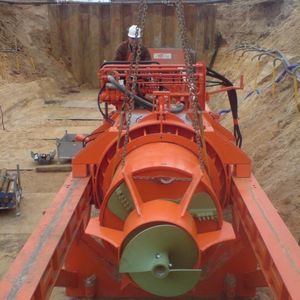
Pipe bursting system RBZ series

Add to favorites
Compare this product
Description
With the PERFORATOR RBZ-series bursting systems, pipes can be renewed and renovated in an environmentally friendly manner and without trenching in old routes. Depending on the requirements and the damage to the old pipeline, various methods can be used.
The static pipe bursting method is used for the renewal of pipelines in old routes. Regardless of whether it is a gravity or pressure pipeline, the old pipeline is cut into segments by breaking or cutting, and displaced radially into the surrounding soil. At the same time, a new pipe of the same or larger dimension is pulled in. The bursting method is suitable for almost all old and new pipe materials.
The pressing/drawing process involves the complete replacement of existing pipelines in a single operation. The old pipe is completely removed from the ground. The new pipe can be drawn in with the same or larger dimensions.
The auxiliary pipe method is also a route-equivalent, complete replacement of existing pipelines in two work steps. It is particularly suitable for old pipes made of cast iron, ductile cast iron, steel and fibre cement. As with other same-route renewal procedures, the new pipe can be pulled in in the same or larger dimension. In the relining process with annular gap, pipe strings or individual pipes are inserted into the existing pipelines. The pipe dimension is reduced and the annular gap is filled depending on the process variant. In relining processes without an annular gap, a PE pipe string with a reduced cross-section is inserted into the old pipeline. In the reduction process, the new pipe later lies close to the old pipe wall (close-fit). Both process variants
Catalogs
RBZ 60/160
4 Pages
Related Searches
*Prices are pre-tax. They exclude delivery charges and customs duties and do not include additional charges for installation or activation options. Prices are indicative only and may vary by country, with changes to the cost of raw materials and exchange rates.












